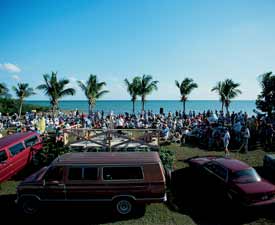
While most of North America freezes, amateur astronomers flock to the Florida Sun for the annual Winter Star Party.
Stephen James O'Meara
When I was a novice skywatcher in the 1960s, my teenage buddies and I didn’t know what a “star party” was. But we had them anyway. A group of us would get together in a vacant lot or somebody’s backyard, set up a few telescopes, and have a ball observing the night sky while swapping tall tales about girls and cars. That’s still what any star party is about — enthusiastic amateur astronomers enjoying the heavens and each other’s company.
Over the last 40 years, star parties have become an important part of the amateur astronomer’s life, and for good reason: if you want to get a good look at “deep-sky” objects — the star clusters, nebulas, and galaxies that lie beyond our solar system — you need a dark sky. Unfortunately, backyards and vacant lots are not an option for many of us anymore. Due to the growth of light pollution, many urban and suburban astronomers can’t see much more with their unaided eyes than the Moon, planets, and a few dozen bright stars. Some of the sky’s true showpieces often present nothing more than a dim, fuzzy smudges.
Consequently, organized get-togethers at locations away from city lights provide many stargazers with their only opportunities to see the night sky as it should be seen. Even if you don’t own a telescope, you’ll find that country skies let you see more than you thought possible. Away from streetlights, the Great Andromeda Galaxy (M31) is easily visible to the unaided eye despite being 2½ million light-years away.
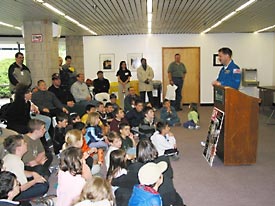
Not every gathering features celebrities like NASA astronaut John Grunsfeld, but most offer interesting, informative speakers that can help you learn about the sky.
S&T image: Richard Tresch Fienberg
Another reason to attend is the chance to check out all the telescopes — maybe 20 at a local affair, maybe 300 or 400 at a big event. Sure, it’s fun to drool over manufacturers’ full-color advertisements in magazines, and equipment reviews can be helpful when you’re trying to choose a first telescope. But it’s far better to see a field full of telescopes and accessories in person. Nothing substitutes for the hands-on experience of a star party. You’ll get to “test drive” a wide variety of scopes, and you’ll learn a lot by asking your fellow attendees about the equipment they use.
Hitting the Party Circuit
So where do you begin? Most local astronomy clubs sponsor monthly public-observing sessions on weekends near new Moon. These can provide newcomers with an easy introduction to the star-party scene. In fact, local get-togethers may be the best place to get your feet wet. Many clubs devote their monthly star parties at least partially to educating and assisting new members. To locate an astronomy club in your area, check SkyandTelescope.com's online listings.
Regional star parties are a step up from local gatherings. Some of these are nearly as well attended as the largest national events, but most draw relatively small groups of 100 to 150 observers. These star parties offer many of the pluses of large gatherings, including speakers and daytime activities, but in a relaxed atmosphere similar to that found at the local level. Since regional events may not be publicized in astronomy magazines or online, the easiest way to find the ones in your part of the country is to ask around at your astronomy club.
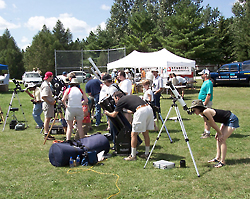
Not all observing at star parties is at night. Solar observing was the order of the day at Starfest in Canada.
If you’ve got the time and inclination, then consider going to one of the national events. Owing to their huge size, large gatherings aren’t quite as novice-friendly as local or regional meets — they might even be a little intimidating for the beginner. But where else are you going to find so many like-minded stargazers in one place? It can be a thrilling, fulfilling experience.
Each has its own character, so first check the list of Annual Events online for likely candidates, then visit the websites of the ones that appeal to you and check them out. Many star parties offer cabins and catered meals, but at others camping out and cooking your own food are the only options. Whatever your preferences, be sure to choose early enough to secure a spot — many of the premier events sell out quickly.
You can also search the Calendar for additional events near you.
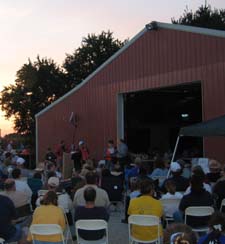
Hopeful attendees gather around the barn at sunset for the door-prize drawing at Astrofest 2004, held in mid-September near Kankakee, Illinois.
S&T: J. Kelly Beatty.
Get Ready to Party
OK, so you’ve picked an event to attend, and you’re looking forward to going. Don’t worry about whether your telescope is “good enough.” Everybody has to start somewhere, and that person scanning the skies with her giant reflector probably started out with a small department-store scope. What if you don’t have a telescope of any kind? Again, don’t worry. If you have a pair of binoculars, bring them, but all you really need are your eyes.
Since you’ll probably be able to see lots more stars than you can from home, a star party offers an excellent opportunity to start or continue learning the constellations. So you’ll want to have some kind of star chart. You’ll also need a red-filtered flashlight to read your charts while preserving your night vision and that of your fellow astronomers. And it’s nice to have a small table — a folding tray table perhaps — close at hand for eyepieces and star charts.
What can you expect when you arrive? If it’s a local club meet, things are simple. Say “Hi” to your star-mates, plunk your scope down, observe for as long as you want, and then pack up and leave. It’d be a good idea to arrive while there’s still enough light to set up your gear.
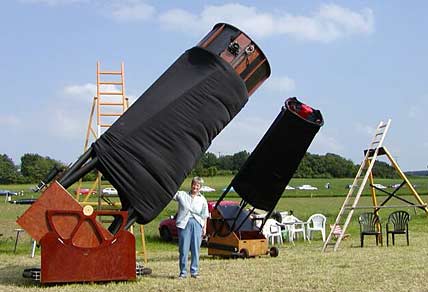
Star-party organizers strive to provide unique, inviting activities. Where else can you look through a 12-foot-tall telescope?
The experience is a little different at a regional or national gathering. There are telescopes — small, medium, and huge — as far as the eye can see, and people, hordes of people. It can be a real culture shock, but take heart. You’ll find many fellow star-party novices on the field. And a sure cure for those first-time jitters is the warm reception you’ll get from your fellow star-partiers. Walk up to a group shooting the bull on the field and introduce yourself, and you’ll be included in short order.
Up All Night
Once darkness falls you’re going to be mightily impressed by what you see overhead. So figure on spending some time just staring open-mouthed at the sky before you do anything with a telescope. Having skies that are so much darker than what you left back home is both good and bad. Incredibly dark skies will allow your telescope and your eyes to perform to the limits of their potential. But some people find that all the extra stars seen in pristine skies make even the most familiar constellations look different and confusing.
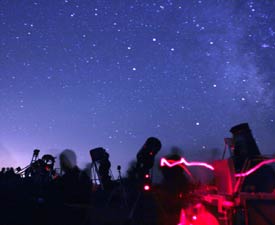
A star party in a remote setting gives you a chance to enjoy the night sky (especially the Milky Way) in all its glory and to enjoy the company of other stargazers.
By all means, stay up until the Milky Way rises. Winding its way through the constellations, it’s no longer a dim band but an unforgettable deep-sky object in its own right that spans the entire sky. At one of my first real star parties, I started disassembling my telescope well before midnight. When one of the veteran club members enquired as to why, I pointed to the “clouds” rolling in from the east. “Son,” the old hand chuckled, “that’s the Milky Way rising.”
If you’re like most new star-party attendees, it will be hard for you to get into an all-night observing groove. But try to take full advantage of those superb skies by pulling at least one all-nighter. If you can stick with it into the wee hours, the heavens will roll on, bringing exciting “new” constellations into view. One way to keep going until dawn is to take frequent breaks. Have some coffee and a snack. Stroll around the field. Check out the views in some other scopes. Who knows? You may find yourself climbing a ladder to reach the eyepiece of an immense scope!
Viewing the night sky is wonderful anytime. But being able to experience it with friends and loved ones under perfectly dark skies is an especially thrilling and literally eye-opening experience for any stargazer, old or new.
An engineer by profession, Rod Mollise teaches astronomy labs at the University of South Alabama in Mobile.
 0
0
Comments
You must be logged in to post a comment.